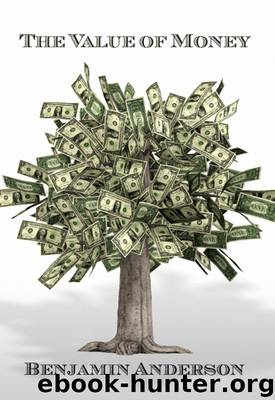The Value of Money by Benjamin Anderson

Author:Benjamin Anderson [Benjamin Anderson]
Language: eng
Format: epub
ISBN: 978-1-61016-277-7
Publisher: The Macmillan Company
Published: 1917-11-06T16:00:00+00:00
1 Vide ch. 16 for a more precise statement of this part of quantity theory doctrine.
1 Purchasing Power of Money, pp. 169–170.
2 Ibid., p. 170.
3 Ibid., p. 171.
4 Ibid., p. 172.
1 Ibid., p. 172. Italics mine.
2 Ibid., pp. 174–181.
1 I call attention, in passing, to Fisher’s confusion, in this sentence, of “commodities” with “trade.” This occurs frequently in his argument. Cf. pp. 225–226, supra.
1 The capitalization theory is briefly outlined by Böhm-Bawerk, in the critical and historical volume of his Kapital und Kapitalzins (English title of the volume, Capital and Interest), in his criticisms of the theories of Henry George and Turgot. It has subsequently been elaborated, and much improved, by Fetter, in his Principles of Economics, and, more recently, has been restated, with mathematical formulæ, by Fisher, in his Rate of Interest. A good brief statement will be found in Seligman, Principles of Economics, ch. on “The Capitalization of Value.” Extensive use has been made of it by Veblen. More recently, it has been elaborated in the controversy over the theory of interest participated in by Seager, Fisher, Brown and Fetter, in the American Economic Review, 1912–13–14, and the Quarterly Journal of Economics, 1913.
1 Italics mine.
2 The criticisms I should make of the present formulations of the time-preference theory of interest, as presented by Böhm-Bawerk, Fetter and Fisher, rest on the individualistic method of approach, and are at many points analogous to the criticisms I have made of the utility theory of value. These criticisms need not affect the points at issue here. On the particular point involved, I agree with Fisher that the productivity theory gives a wrong answer.
1 E. g., Fisher, Purchasing Power of Money, p. 179.
1 This confusion is a companion of the confusion between volume of goods in existence, or volume of production, and volume of goods exchanged. The errors growing out of this confusion have been dealt with in ch. 13, especially pp. 225–226. Virtually all quantity theorists make both these mistakes.
2 The fundamental causation is psychological, and calls for a theory of value, as distinguished from exchange-relations.
1 Supra, chapter on “Velocity of Circulation.”
2 This distinction is clearly made and developed by von Wieser, in the two articles referred to in our chapter on “Marginal Utility.” It is used by him in criticisms of the quantity theory. “Der Geldwert und seine geschichtlichen Veränderungen,” Zeitsch. für Volkswirtschaft, Sozialpolitik und Verwaltung, XIII, 1904; discussions in Schriften des Vereins für SozialPolitik, 1909, no. 132. A similar distinction runs through J. A. Hobson’s Gold, Prices and Wages, London, 1913. The present writer had worked out the line of argument here presented before reading either of these discussions.
1 I have chosen maid-servants, to avoid complications of costs of production in the reasoning that might come if other labor, engaged in producing goods for the market, were selected. To tighten the argument a little further, I assume that the masters receive their monthly incomes on the first day of the month; that they pay the maids on the same day;
Download
This site does not store any files on its server. We only index and link to content provided by other sites. Please contact the content providers to delete copyright contents if any and email us, we'll remove relevant links or contents immediately.
International Integration of the Brazilian Economy by Elias C. Grivoyannis(90771)
The Radium Girls by Kate Moore(11921)
Turbulence by E. J. Noyes(7935)
Nudge - Improving Decisions about Health, Wealth, and Happiness by Thaler Sunstein(7615)
The Black Swan by Nassim Nicholas Taleb(7010)
Rich Dad Poor Dad by Robert T. Kiyosaki(6399)
Pioneering Portfolio Management by David F. Swensen(6226)
Man-made Catastrophes and Risk Information Concealment by Dmitry Chernov & Didier Sornette(5921)
Zero to One by Peter Thiel(5684)
Secrecy World by Jake Bernstein(4643)
Millionaire: The Philanderer, Gambler, and Duelist Who Invented Modern Finance by Janet Gleeson(4374)
The Age of Surveillance Capitalism by Shoshana Zuboff(4209)
Skin in the Game by Nassim Nicholas Taleb(4161)
Bullshit Jobs by David Graeber(4094)
The Money Culture by Michael Lewis(4075)
Skin in the Game: Hidden Asymmetries in Daily Life by Nassim Nicholas Taleb(3929)
The Dhandho Investor by Mohnish Pabrai(3698)
The Wisdom of Finance by Mihir Desai(3650)
Blockchain Basics by Daniel Drescher(3500)
